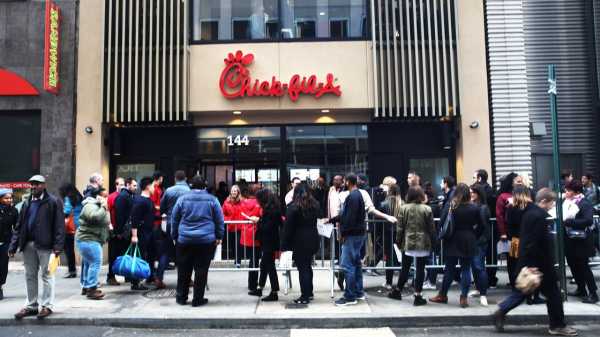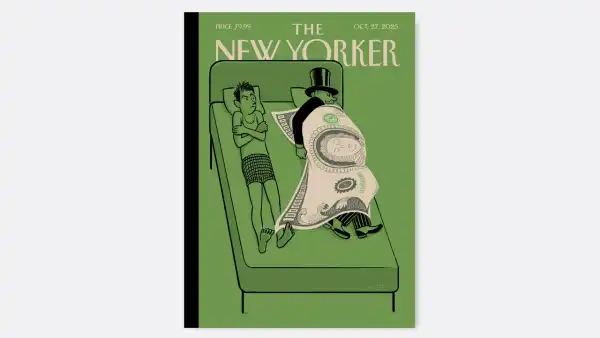
During the lunch break, I was alone on the roof of the largest chick-fil-a in the world. In the restaurant, on Fulton Street, is the fourth company in Manhattan, and it opened last month on the kind of slick, corporate-friendly fanfares that welcome a new chain. The first one hundred customers took part in a hunt around the financial district. At the ceremony, the guide honoured them with a year’s supply of free chicken sandwiches and waffles. There were no such prizes on offer when I visited, but on the fifth floor and a terrace on the upper floor of the restaurant, which is twelve thousand square feet—I could see that the queue to get in stretched almost to the end of the quarter. The employee took orders on the touch screen and driven people through the doors. The air smelled of fried.
New York took Chik-fil-A. one of the locations of Manhattan, estimates that she sells a sandwich every six seconds, and the company has announced plans to open a dozen stores in the city. And the arrival of brand like infiltration, largely because of its pervasive Christian traditionalism. Its headquarters in Atlanta, decorated with verses from the Bible and a statue of Jesus washing the disciples ‘ feet. Its stores close on Sundays. Its CEO Dan Cathy was accused of fanaticism. “We are inviting God’s judgment on our country,” he once said, “when we shake our fist and say, ‘we know better than you what constitutes a marriage.’ ” The company reiterated its intention to “treat every person with honor, dignity and respect,” but they quietly continued to donate to anti-L. G. B. T. groups. When the first stand-alone new York city opened, in 2015, there was a crowd of protesters. When you open a place in Queens shopping Mall, in 2016, mayor bill de Blasio proposed a boycott. No such contradictions welcomed the opening of a new Outpost. Chick-fil-a success is a marketing coup. Its expansion raises questions about what we expect from our fast-food, and to what extent the company may join the community.
I noticed that the word community is scattered everywhere on the street, in the restaurant, Fulton. Shelves of children’s books bears a plaque testifying to “our love for this local community.” The tables are made of heat-treated wood, which creates, according to chick-fil-a press release, “warm space to build community.” Board with the heading “our community” displays the drawing with chalk on the town. Outside, you can see an earlier iteration of that landscape on the facade of the building, which, with two tall, powerful rectangles jutting out, “gives a subtle impression of the twin towers.”
This emphasis on community, particularly in delusion to blame on 9/11, suggests an ulterior motive. Corporate objectives restaurant still begins with the words “praise God”, and that proselytism is a humming beneath the surface of the street, Fulton restaurant, which the ersatz homespun in addition, the megachurch. David Farmer, chick-fil-a Vice President with experience in restaurants, told buzzfeed that he is committed to the “pit crew efficiency, but where you feel like you just hugged in the process.” This is a contradiction, but industrial settlement, in the center of the new restaurant and chick-fil-a all brand. Nowhere is this clearer than in cows.
It is impossible to overestimate the role of cows in an official communiqué, they always take a capital “C”—which are displayed in framed portraits to the whole area of Fulton Street. If the restaurant is a mega Church, cow its ultimate evangelists. Since their emergence in the mid-nineties when they began to advise Atlanta motorists to “eat Mor CHIKIN”—they remain one of the most popular and the most painful advertising campaigns in fast-food history, it is important that chick-fil-a corporate culture. S. Truett Cathy, the chain’s founder Dan Cathy’s late father, saw them as a tool to spread the gospel chicken. In my Christian business books “eat Mor Chikin: inspire more people” since 2002, he recalls the roar of the children’s party at chick-fil-a in HAMPTON, GA. Swinging plush toy cow in front of the birthday girl, he asked her: “what do cows say?”
She looked at me, puzzled. (Remember, she was barely three.)
“What the cow say?” I repeated.
“MOO”, she replied.
All laughed at her a very good answer, and I gave her a cow and
hugged and whispered the real answer to it. Then I turned back to her mother.
and asked: “What do cows say?”
“Eat more chicken!” her mother cried . . . then, one by one, each
people quotes the cows and laughed.
Cathy died a billionaire in 2014, but “eat Mor CHIKIN” mantra survives. Although cows have never bothered to improve their writing, the franchise continues to hold annual cow assessment day, offering a free meal to anyone dressed as a cow. Employees dance around in cow costumes. Advertising Manager of the company is its “cow king”. Cows have their own calendar. (This year’s theme – “rules of yesteryear.”) They were entered into the Madison Avenue walk of fame, and a Facebook following is approaching seven figures. Stan Richards, head of the advertising Agency that created the cows, the Richards group, they are equated with “guerrilla insurgency” in his book “the silent Kingdom”: “one consumer wrote to tell us, the campaign has been so effective that every time he sees the cows he thinks chicken. We have co-opted the whole species”.
It’s worth asking why Americans fell in love with an ad in which one animal begging us to kill another in his place. Most restaurants take effort to distance themselves from the brutality of the massacre; chick-fil-a invites us to go along with cows Schadenfreude. In portraits on the street in the restaurant, Fulton, cows various attractions of new York. They are in Central Park, where “eat Mor CHIKIN” was mowed into the lawn. They are looking at the Manhattan bridge from Dumbo, where they were changed to a stop sign: “stop to eat burgrz”. They’re in the subway, where advertising . . . you get the picture. The joke is that cows have no place in new York-winking confirmation that chick-fil-a is not quite here.
His arrival in the city, the augurs worse than a pile of manure on the train. According to a report from the center for urban future, the number of chain restaurants in new York city has doubled since 2008, ousting Diners and greasy spoons for which the rent is too expensive. Chick-fil-a, meanwhile, is going to become third largest fast food chain in the country, trailing only McDonald’s and Starbucks. No matter how well these restaurants to integrate into the community, they are still revered deadening uniformity. Uniform eating is the food chain know that their main attractiveness is palliative. With ads and shop Windows, they have the resources to show that they have always been here for us, and recent trends show that we prefer them for something new, untested.
The defenders of chick-fil-a say that the companies donate thousands of pounds of food to new York Common pantry, and that expansion creates jobs. The more fatalistic I should add that hypocrisy is baked, or grilled, each consumer experience is that of unrestrained corporate power makes it impossible to bring Your purse in accordance with its principles. However, there is something particularly nasty about chick-fil-A, which tries to present itself better than other fast food: cleaner, softer, and more ethical meat is a bit healthier than meat burgers. His policies, his style, and his trade-inflected gospel Message with that of suburban piety. Once told Adweek the representative of the Richards Group, “people root for the low status of the character, and the cows are low status. They are deprived”. This could be true in 1995, when chick-fil-a was a lowly brand Mall trying to find its footing against the Juggernaut Burger. Today cows “guerrilla uprising” is more of a carpet bombing. New Yorkers are not required to repeat what they say. Enough, we can tell them. NO MOR.
Sourse: newyorker.com






